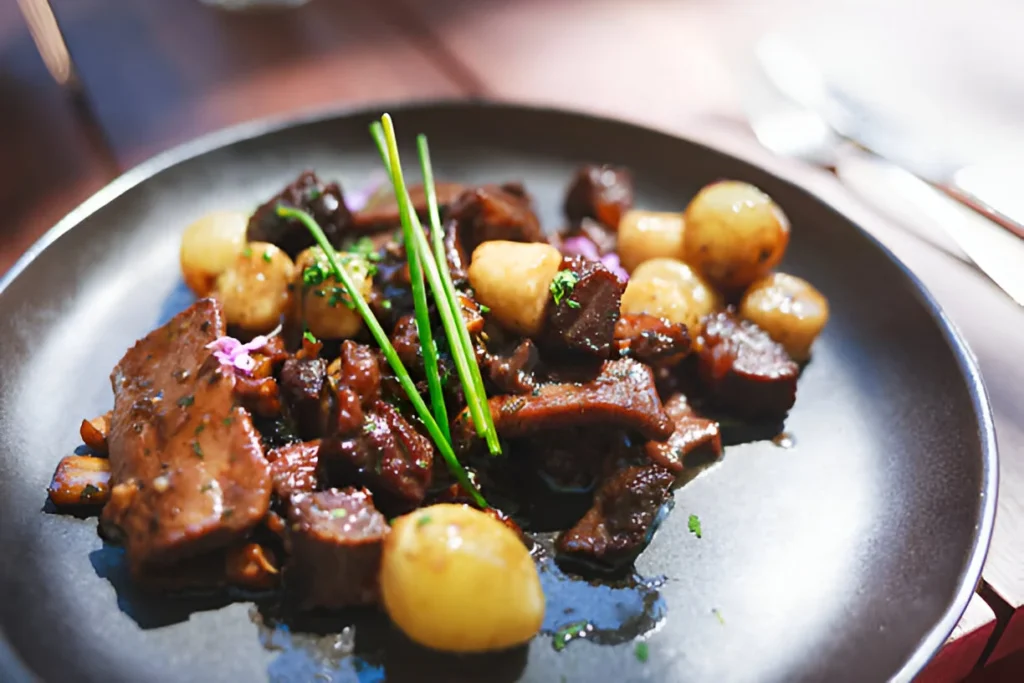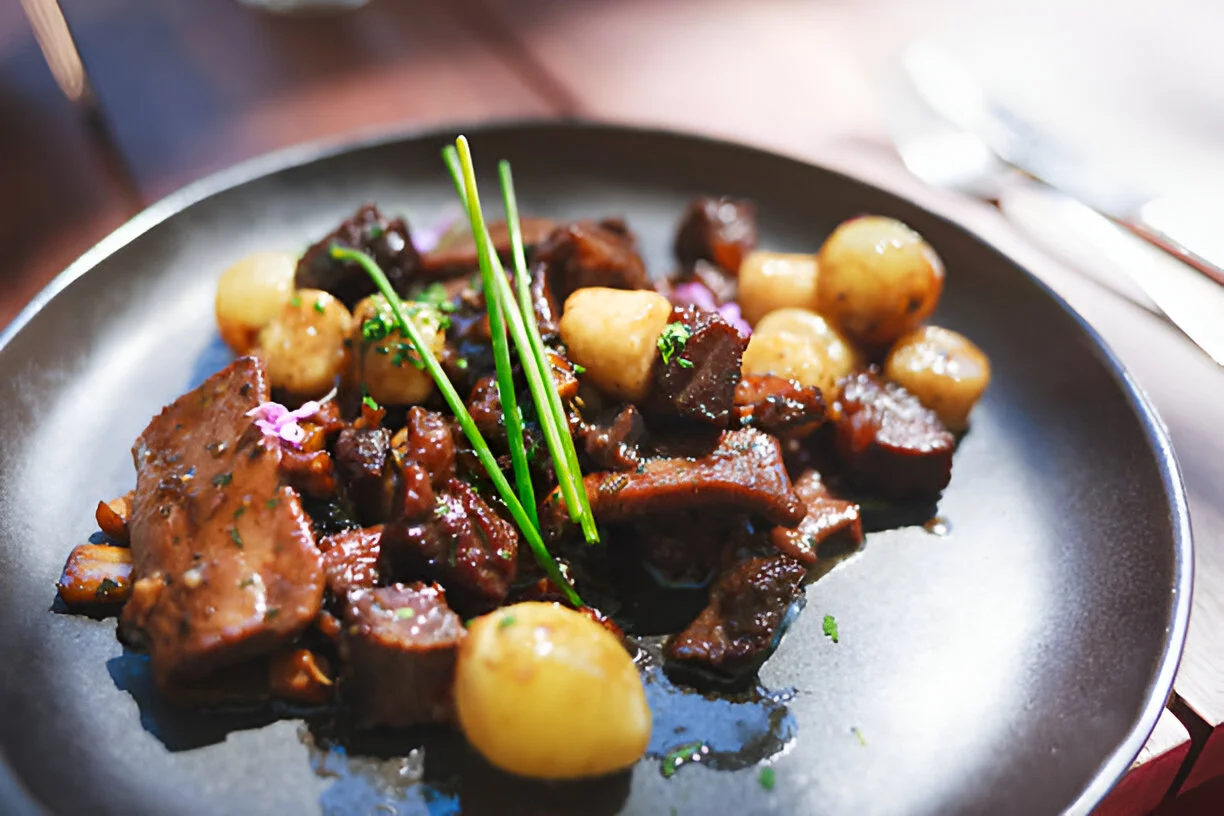Table of content:
Introduction to Venison Roast
- Overview of venison as a game meat
- Benefits of cooking with venison
- Importance of choosing quality meat for the roast
- Preparing for the Perfect Venison Roast
- Selecting the right cut of venison
- Essential tools and equipment for roasting
- Recommended herbs and spices for seasoning
- Step-by-Step Instructions for Cooking Venison Roast
- Step 1: Marinating the venison (include marinade recipe)
- Step 2: Prepping the roast: tying, seasoning, and browning
- Step 3: Roasting techniques (oven roasting vs. slow cooking)
- Achieving the Ideal Internal Temperature
- Explanation of safe cooking temperatures for venison
- Tips for using a meat thermometer
- How to check for doneness visually
- Serving Suggestions and Side Dishes
- Ideal side dishes to complement venison roast (e.g., mashed potatoes, roasted vegetables)
- Recommended sauces or gravies to enhance flavor
- Pairing wines or beverages with venison
Conclusion and Final Tips
- Recap of key points for a successful venison roast
- Encouragement to experiment with different herbs and cooking methods
- Invitation for readers to share their experiences or variations of the recipe

Introduction to Venison Roast
Overview of Venison as a Game Meat
Venison roast refers to the meat obtained from deer and is considered a delicacy in many cuisines around the world. Unlike conventional meats, venison is known for its lean quality and rich flavor, making it a popular choice for those looking to explore game meats. Its unique taste can be attributed to the deer’s natural diet, which consists of grasses, leaves, and other vegetation.
Benefits of Cooking with Venison
Cooking with venison offers several nutritional benefits:
- Low in Fat: Venison is significantly lower in fat compared to beef and pork, making it a healthier protein option.
- High in Protein: It’s a great source of high-quality protein, essential for muscle repair and overall health.
- Rich in Vitamins and Minerals: Venison is packed with vitamins B6 and B12, iron, and zinc, contributing to a balanced diet. Additionally, venison has a distinctive flavor that can elevate your culinary creations, making it a favorite for gourmet dishes and special occasions.
Importance of Choosing Quality Meat for the Roast
When preparing a venison roast, the quality of the meat is paramount. Here are some factors to consider:
- Source: Opt for venison that is sourced from reputable suppliers or hunters who practice sustainable hunting methods.
- Freshness: Fresh venison will have a vibrant color and a clean, gamey smell. Avoid any meat that appears discolored or has an off odor.
- Cut Selection: Different cuts of venison have varying tenderness and flavor profiles. Popular choices for roasting include the loin, shoulder, and leg. Selecting the right cut is essential for achieving the perfect roast.
Preparing for the Perfect Venison Roast
Selecting the Right Cut of Venison
Choosing the right cut of venison is crucial for ensuring a flavorful and tender roast. Here are some popular cuts to consider:
- Loin: Known for its tenderness, the loin is often considered the best cut for roasting. It has a mild flavor and can be cooked quickly for a succulent result.
- Shoulder: This cut is more affordable and has great flavor. It benefits from slow cooking, which breaks down the connective tissues, resulting in a moist and tender roast.
- Leg: The hind leg cut can be used for roasting or braising. It’s slightly tougher than the loin but offers a rich flavor that can be enhanced with proper seasoning and cooking techniques.
Essential Tools and Equipment for Roasting
Having the right tools can make the process of cooking a venison roast much easier and more enjoyable. Here are some essential items you’ll need:
- Roasting Pan: A sturdy roasting pan with a rack is ideal for allowing heat circulation around the meat, promoting even cooking.
- Meat Thermometer: An accurate meat thermometer is essential for checking the internal temperature of the roast, ensuring it is cooked perfectly and safely.
- Sharp Knives: A good set of sharp knives will help with trimming the meat and carving the finished roast.
- Cutting Board: A sturdy cutting board is necessary for preparing the meat and carving once it’s cooked.
Recommended Herbs and Spices for Seasoning
Seasoning is key to enhancing the natural flavors of venison. Here are some popular herbs and spices that pair beautifully with venison:
- Rosemary: Its robust flavor complements the gamey taste of venison, making it a classic choice for seasoning.
- Thyme: This herb adds a subtle earthy flavor that works well when combined with other seasonings.
- Garlic: Fresh garlic or garlic powder can enhance the meat’s flavor, adding depth and richness.
- Juniper Berries: These berries have a slightly sweet and piney flavor that complements venison wonderfully. You can crush them and use them in marinades or rubs.
- Salt and Pepper: Don’t forget the basics! A generous seasoning of salt and freshly cracked black pepper is essential for bringing out the flavors.
Step-by-Step Instructions for Cooking Venison Roast
Step 1: Marinating the Venison
Marinating venison helps to enhance its flavor and tenderness. Here’s a simple marinade recipe to help you get started:
Marinade Recipe:
- Ingredients:
- 1 cup red wine (or balsamic vinegar for a non-alcoholic option)
- 1/4 cup olive oil
- 3 cloves garlic, minced
- 2 tablespoons fresh rosemary, chopped (or 1 tablespoon dried)
- 1 tablespoon fresh thyme, chopped (or 1 teaspoon dried)
- Salt and black pepper to taste
Instructions:
- In a bowl, whisk together the red wine, olive oil, minced garlic, rosemary, thyme, salt, and pepper.
- Place the venison roast in a resealable plastic bag or a shallow dish and pour the marinade over it to ensure the meat is fully coated.
- Seal the bag or cover the dish and refrigerate for at least 4 hours, or preferably overnight, to allow the flavors to penetrate the meat.
Step 2: Prepping the Roast: Tying, Seasoning, and Browning
Once marinated, it’s time to prepare the roast for cooking:
- Tying: Use kitchen twine to tie the roast if it’s uneven in thickness. This helps it cook evenly and maintain its shape.
- Seasoning: Remove the roast from the marinade and pat it dry with paper towels. Season generously with salt and pepper, and if desired, rub on additional herbs like rosemary or thyme for extra flavor.
- Browning: In a large skillet, heat a bit of olive oil over medium-high heat. Sear the roast on all sides until you achieve a nice brown color (about 3-4 minutes per side). . This step develops a rich flavor through the Maillard reaction.
Step 3: Roasting Techniques (Oven Roasting vs. Slow Cooking)
You can choose between oven roasting and slow cooking, depending on your preference and time availability:
- Oven Roasting:
- Preheat your oven to 375°F (190°C).
- Place the browned roast in a roasting pan and insert a meat thermometer into the thickest part of the meat.
- Roast in the preheated oven until the internal temperature reaches your desired doneness (typically 130°F/54°C for medium-rare, 140°F/60°C for medium).
- Remove from the oven and let it rest for 10-15 minutes before slicing to retain juices.
- Slow Cooking:
- If using a slow cooker, place the browned roast in the slow cooker along with any remaining marinade and some chopped vegetables (like carrots and onions) for added flavor.
- Cook on low for 6-8 hours, or until the meat is tender and easily pulls apart with a fork.
- Once done, let it rest for a few minutes before carving.
Achieving the Ideal Internal Temperature
Explanation of Safe Cooking Temperatures for Venison
Cooking venison to the appropriate internal temperature is crucial not only for flavor but also for food safety. Here are the recommended safe cooking temperatures for venison:
- Medium-Rare: 130°F (54°C) – This temperature will yield a juicy, tender roast with a warm, red center.
- Medium: 140°F (60°C) – At this temperature, the meat will be pink throughout, offering a balance of tenderness and flavor.
- Medium-Well: 150°F (65°C) – This results in a slightly firmer roast with just a hint of pink.
- Well-Done: 160°F (71°C) and above – While this ensures safety, it can lead to a drier texture, so it’s best to avoid this level if possible.
Tips for Using a Meat Thermometer
To achieve accurate readings with a meat thermometer, keep these tips in mind:
- Insert Correctly: Insert the thermometer into the thickest part of the roast, avoiding bone and fat, which can give false readings.
- Check Early: Start checking the internal temperature about 15-20 minutes before the estimated cooking time. This helps prevent overcooking.
- Keep it Steady: Leave the thermometer in place for a few seconds to allow it to stabilize before reading the temperature.
- Use Instant-Read Thermometers: These provide quick readings, making it easier to monitor your roast without losing much heat.
How to Check for Doneness Visually
In addition to using a thermometer, you can check for doneness visually. Here are some indicators to look for:
- Color: For medium-rare, the center should be a warm red, while medium will have a pink hue throughout. As it cooks more, the color will change to a light brown.
- Texture: Gently press the roast with your finger or a utensil. A medium-rare roast will yield slightly, while a medium roast will feel firmer but still have some give.
- Juices: When you cut into the roast, the juices should run clear for well-done, while a medium-rare roast will have a slight pink tint to the juices.
Serving Suggestions and Side Dishes
Ideal Side Dishes to Complement Venison Roast
When serving venison roast, choosing the right side dishes can elevate your meal. Here are some ideal options to consider:
- Mashed Potatoes: Creamy mashed potatoes are a classic pairing that adds a comforting element. You can enhance them with garlic or herbs for extra flavor.
- Roasted Vegetables: Seasonal roasted vegetables, such as carrots, Brussels sprouts, and parsnips, bring sweetness and color to the plate, complementing the rich flavor of the venison.
- Wild Rice Pilaf: This nutty side dish adds texture and earthiness, making it a perfect match for the gamey taste of venison.
- Sautéed Greens: Sautéed kale or Swiss chard with garlic and olive oil provides a healthy and flavorful contrast to the richness of the roast.
Recommended Sauces or Gravies to Enhance Flavor
Adding a sauce or gravy can take your venison roast to the next level. Here are some popular options:
- Mushroom Sauce: Sautéed mushrooms, shallots, and garlic combined with cream or beef stock make a rich, earthy sauce that pairs beautifully with venison.
- Berry Sauce: A sauce made from fresh or frozen berries (like blackberries or cranberries) simmered with sugar and a splash of wine adds a sweet-tart contrast that complements the meat’s flavor.
- Herbed Gravy: Traditional gravy made from the pan drippings, thickened with a roux, and flavored with fresh herbs provides a classic touch.
Conclusion and Final Tips
In conclusion, preparing a successful venison roast involves several key elements that ensure a flavorful and tender dish. Here’s a recap of the essential points:
- Choosing Quality Meat: Start with high-quality venison, as it significantly impacts the flavor and texture of your roast 1.
- Proper Cooking Techniques: Whether you opt for oven roasting or slow cooking, pay attention to the cooking times and temperatures to avoid overcooking, which can lead to dryness 2.
- Seasoning and Marinades: Experimenting with different herbs and marinades can enhance the natural flavors of the venison, making each roast unique.
I encourage you to experiment with various herbs and cooking methods. Happy cooking, and may your venison roasts be ever succulent and satisfying!
You maybe like: Peach Cobbler Recipe with Cake Mix

1 thought on “How to Make the Perfect Venison Roast: A Step-by-Step Recipe”